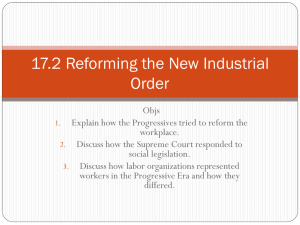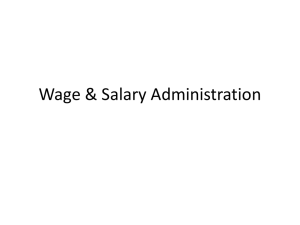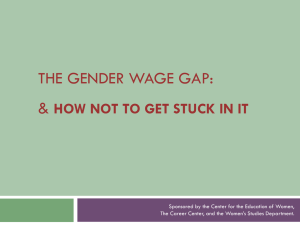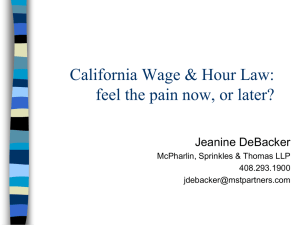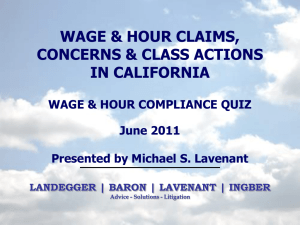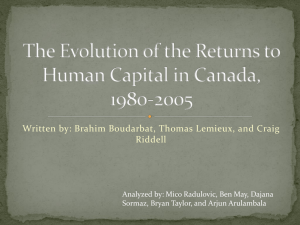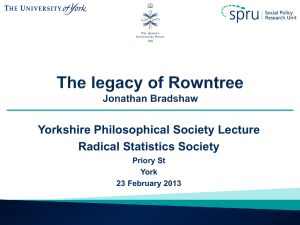Implementing Minimum Wage Rates for Southeast Asia with the
advertisement
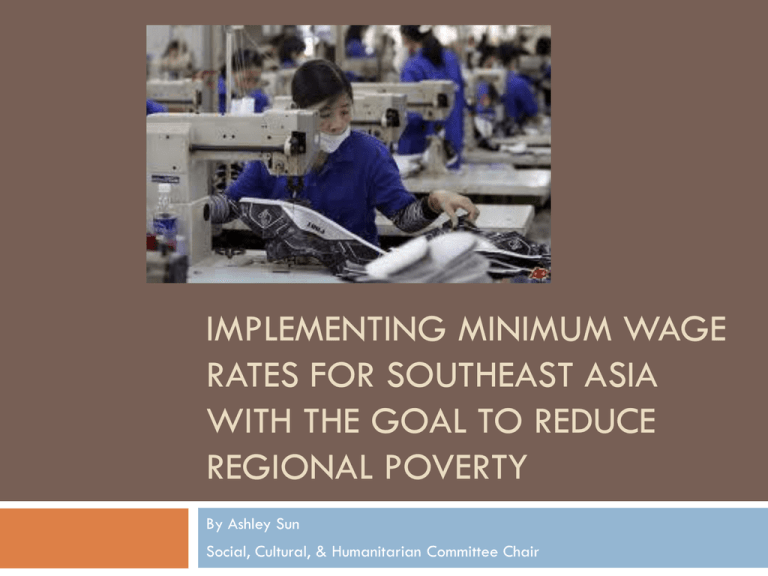
IMPLEMENTING MINIMUM WAGE RATES FOR SOUTHEAST ASIA WITH THE GOAL TO REDUCE REGIONAL POVERTY By Ashley Sun Social, Cultural, & Humanitarian Committee Chair Introduction The number of workers in Southeast Asia living in poverty is extremely high. Hundreds of the working poor in many of these countries earn less than USD $2 per day. In India, 456 million people earn USD $1.25 per day, which is considered the threshold of poverty around the world. 36% of Southeast Asia’s population lives in poverty, the second highest rate in the world, only behind sub-Saharan Africa’s 47.5%. These people deserve no less than citizens of developed countries do, but living in poverty hinders their economic and social development greatly. Therefore, by focusing in Southeast Asia, implementing minimum wage rates in this specific region will target ways to begin reducing the issue of poverty to increase the standard of living. Definition of Key Terms Poverty – Defined by the Oxford Dictionary, poverty is the state of lacking sufficient money to live at a standard considered comfortable or normal in society. The UN defines it is a denial of choices and opportunities, a violation of human dignity. It means insecurity, powerlessness, and exclusion of individuals or communities, susceptibility to violence, and often implies living on marginal or fragile environments. Poverty is much more than simply an economic situation; it is a social problem and political issue that affects all facets of life. Definition of Key Terms (cont.) Minimum Wage – According to the MerriamWebster dictionary, minimum wage is the minimum amount of compensation an employee must receive for performing labor, which is typically established by contract or law of the government. Definition of Key Terms (cont.) Southeast Asia – For the purposes of this conference, Southeast Asia will be defined as a subregion of Asia that includes Brunei, Cambodia, East Timor, Indonesia, Laos, Malaysia, Burma, Philippines, Singapore, Thailand, and Vietnam. Overview Poverty has always been an issue afflicting millions of people around the world, with Southeast Asia being no exception. The first Millennium Development Goal (MDG1), which was to eradicate extreme poverty and hunger, has been improving such situations around the world. Implementation of a minimum wage rate is an example of such an improvement. Overview (cont.) Minimum wages were originally implemented with the idea to help the least able members of a work force. By doing so, they were also used as a method to control the proliferation of sweatshops in large manufacturing factories. In these sweatshops, factory owners often mistreated their workers or paid them substandard wages. Implementing minimum wages were a way for the owners to pay their workers “fairly”. It was first established in Australia and New Zealand in response to bitter strikes in the 1890s, which then quickly spread to Massachusetts starting in 1912. Overview (cont.) Today, there are movements to establish or continue minimum wages in almost 90% of all countries around the world. In the European Union, 18 out of the 27 member states currently have national minimum wages. Many of these countries do not have minimum wage laws established but instead depend on trade unions to set minimum wage rates through collective bargaining, the process of negotiations between the employer and the workers to regulate working conditions. While some minimum wage rates may seem low (especially in the United States), they are enough to raise people beyond the poverty line. For example, the current federal minimum wage in the United States is $7.25 USD, translating into an annual income of $15,080 for a single full time worker. Overview (cont.) In order to establish sustainable economic growth in a country, guarantee of basic human rights and a secure income are necessary. Both can be achieved with the implementation of minimum wages. First of all, the minimum wage gives workers fair compensation for their labor, which could potentially lead to an increase consumer spending and therefore stimulate the economy which is greatly needed in some countries that have been hit hard by the economic crises of the past decade. Furthermore, the establishment of a minimum wage promotes gender equity and fair treatment, closing the income gap between men and women. These are not the only positive aspects of the minimum wage. Overview (cont.) Most agree that minimum wages are implemented with the correct idea to help the poor, but most of the discussion regarding the issue is whether its implementation actually does help workers rise out of poverty. There are four major faults regarding minimum wages. First, minimum wages may actually reduce overall earnings if factory owners become more reluctant to hire more workers. This is happening in Indonesia today, where some companies have had to fire staff by more than 80% than it was 8 years prior. Secondly, if the first situation happens, it creates a scenario where workers have to find jobs in even more abusive and degrading working situations, which may even proliferate with the influx of new workers. Overview (cont.) Third, if the minimum wage is implemented, it means that workers cannot find jobs unless they find employers willing to pay them the wage, meaning further unemployment and further poverty until they find such an employer. Fourth, the minimum wage could decrease incentive for low-skilled workers to learn new and better skills to seek better jobs. Therefore, in order to successfully implement minimum wages, potential solutions would have to be drafted first in response to these problems. Overview (cont.) Major Parties Involved International Labor Organization (ILO) – international UN organization responsible for drawing up and overseeing international labor standards, aiming to promote rights at work, and decent employment opportunities, and enhance social protection; has held several conventions on minimum wages. Major Parties Involved (cont.) Fair Labor Association (FLA) – organization geared to improve worker’s lives based in Washington, promotes adherence to international and national labor laws. Timeline 1890 – First minimum wage instituted in Australia and New Zealand 1938 – First federal minimum-wage law established in the United States (Fair Labor Standards Act) 1949 – ILO Labor Clauses Convention, aiming at ensuring respect for minimum labor standards in the execution of public contracts 1949 – ILO Protection of Wages Convention, establishing that wages shall be paid in regular intervals and that workers shall be free to dispose of their wages as they choose 1970 – ILO Minimum Wage Fixing Convention, requiring ratifying states to establish a minimum wage fixing machinery capable of determining and adjusting the minimum wage accordingly 1990 – ILO met for a regional meeting regarding the issue of minimum wage rates in Southeastern Asia 1992 – ILO Protection of Worker’s Claims Convention, providing for the protection of wage claims 2000 – MDGs are established, the objective of “full and productive employment and decent work” being among the first MDG goal which was to eradicate extreme poverty and hunger Timeline (cont.) 2012 – ILO publishes a research analysis paper called the “Global Wage Report 2012/13: Wages and Equitable Growth”, documenting the differences in wages around the planet, the impact of the economic crisis on them, and policy recommendations on how to establish minimum wages 2012 – After years of cheap labor in Southeastern Asia that translated into vigorous economic growth, governments have responded positively laborer protests for increases in minimum wages to these protests (Indonesia, Thailand, Malaysia, and Vietnam have made increases in their minimum wage rates by as much as 44%) UN Involvement The UN has taken some action in the past to eradicate poverty, seeing that it is currently the first MDG. While eradicating poverty may seem like an impossible goal to reach in just 15 years, several regions have made huge progress and are expected to meet some targets by 2015. The UN has also acted indirectly through the ILO, establishing multiple conventions and agreements to improve the minimum wage in all its member nations. However, the UN has not asked for any direct change or written resolutions on what actions governments should take to enforce the minimum wage. Possible Solutions In response to the four problems stated above in the overview, delegates must keep in mind that there are economic issues that are inherently associated with implementing a minimum wage. Therefore, in order to have a minimum wage that benefits society and does not sink the country’s economy, measures to deal with issues like inflation need to be included in a potential resolution. There needs to be a close connection between the growth of amount of labor and the growth of the worker’s compensation. In addition, reforms will need to be implemented outside of the work force itself. Financial markets need to be reformed to channel resources into productive and sustainable investments to ensure that there is enough profit so companies are capable of establishing minimum wage in the first place. Possible Solutions (cont.) Also, monitoring the progress of poverty reduction has been a difficult task, due to the lack of good quality data taken at steady intervals. This is especially problematic in sub-Saharan Africa where the tools needed to collect a full set of data on MDGs are available in less than half of the countries in that area. Creating a means to monitor the data efficiently would be a very useful tool in tracking the reduction of poverty. Possible Solutions (cont.) Institutions also need to be strengthened. Because it is always hard to organize workers, especially low-wage laborers, more supporting and stronger institutions need to be created for collective bargaining in order to ensure that their rights are protected at all costs. In addition, there is the very clear risk that the number of jobs available will decrease once there is a minimum wage rate. In order to avoid this and actually alleviate poverty, systems like employment guarantee schemes should be put into place to give private firms incentive to comply with the minimum wage and retain the same number of workers. Possible Solutions (cont.) However, in developing/emerging countries, only about half of all workers are actual wage earners while the rest are self-employed or simply unemployed. In order to raise the level of poverty, other measures need to be put in place to create more wage jobs or to raise productivity and earnings of those in self-employment. However, raising efficiency and earnings of the selfemployed means there has to be a raise in the level of nationwide education as well as improved social protection systems by governments or NGOs so that these workers and their families can spend less on the very basic necessities of life and more on things like education. Bibliography Bellman, Eric. "Southeast Asia at a Crossroads on Wages." WSJ.com. Wall Street Journal, 5 Dec. 2012. Web. 13 Feb. 2013. http://online.wsj.com/article/SB10001424127887323316804578160830213287770.html. Card, David, and Alan B. Krueger. "Minimum Wages and Employment: A Case Study of the Fast-Food Industry in New Jersey and Pennsylvania: Comment." American Economic Review 84.4 (1994): 772-93. Print. Gordon, David, Dr. "Indicators of Poverty & Hunger." Lecture. Expert Group on Youth Development Indicators. United Nations Headquarters, New York. 12 Dec. 2005.UN.org. UN. Web. 13 Feb. 2013. http://www.un.org/esa/socdev/unyin/documents/ydiDavidGordon_poverty.pdf. Hoonan, Rose. "Poverty Levels: Where Scarcity Strikes the Hardest." Web log post. The Borgen Project RSS2. N.p., 5 Oct. 2012. Web. 13 Feb. 2013. http://borgenproject.org/poverty-levels/. ILO. "Minimum Wages Key to Cutting Working Poverty, Says ILO." ILO.org. International Labour Organization, 07 Dec. 2012. Web. 13 Feb. 2013. http://www.ilo.org/global/about-theilo/newsroom/news/WCMS_193581/lang--en/index.htm. ILO. Global Wage Report 2012/13. Rep. International Labour Organization, 7 Dec. 2012. Web. 13 Feb. 2013. http://www.ilo.org/wcmsp5/groups/public/---dgreports/--dcomm/documents/publication/wcms_194844.pdf. Nielsen, Robert. "The Advantage Of The Minimum Wage." Robert Nielsen. Wordpress, 27 July 2012. Web. 13 Feb. 2013. http://robertnielsen21.wordpress.com/2012/07/27/the-advantage-of-the-minimumwage/. "WantChinaTimes.com." WantChinaTimes.com. Want China Times, 19 Dec. 2012. Web. 13 Feb. 2013. http://www.wantchinatimes.com/news-subclass-cnt.aspx?id=20121219000110.
